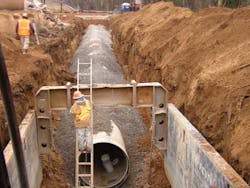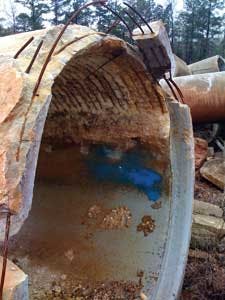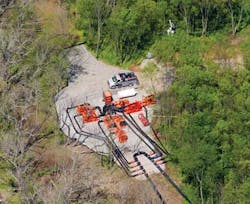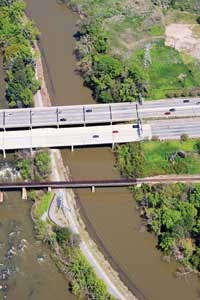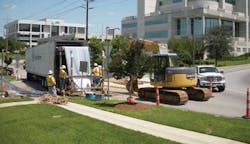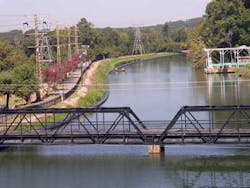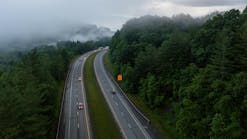Diverting Flow: Bypass Pumps Employed in SC Gravity Sewer Line Rehabilitation
By Edward G. Hart and Phillip P. Dieckmann
Rehabilitating the large-diameter gravity sewer line that conveys wastewater through the heart of downtown Columbia, S.C., was no simple matter. The line was initially installed in the 1970s and had reached the end of its useful life. Two pipeline failures had occurred, and immediate action was required to ensure public safety and avoid severe environmental impacts.
The city of Columbia expanded its sanitary sewer service during the 1970s by upgrading a wastewater treatment plant and installing a large-diameter, reinforced concrete pipe gravity trunk along the Broad and Congaree Rivers. Four decades of hydrogen sulfide exposure brought the trunk line to the end of its useful life. After several sections of the pipeline had collapsed, closed circuit television (CCTV) cameras were run through the pipeline revealing exposed reinforcing steel, root intrusion and other pipe failures.
Once it was determined which portions of the gravity line required the most immediate attention, URS initiated a program that included planning rehabilitation methods and bypass operations; preparing construction plans and specifications; securing permits and approvals; providing assistance during the bidding and award process; performing construction administration and observations services; and coordinating the startup of the projects that would produce the needed improvements.
Location Presents Obstacles
Located in a dense, urban setting, the project required careful planning to economically rehabilitate 498 linear feet (LF) of 60-inch, 9,332 LF of 54-inch and 3,683 LF of 48-inch gravity sewer through the center of downtown Columbia. Portions of the area are located beneath a 150-year-old cemetery, railroads and major thoroughfares, including Interstate-126. Construction required careful consideration regarding the method of rehabilitation, which involved removal and replacement, cured-in-place pipe (CIPP) and the rehabilitation of manholes.
The gravity line was replaced by removing the old pipe and installing new pipe in areas with adequate access. At the lesser-developed upper portion of the project north of the cemetery and the lower portion along the Congaree River, it was possible to use open-cut replacement. However, the middle portion, at depths greater than 25 feet, was located beneath major roadways through downtown Columbia. Open-cut replacement would have resulted in extensive construction excavations, high restoration costs and a severe impact on public and business activities.
To minimize these effects, CIPP installation was used to rehabilitate the 54-inch and 48-inch gravity lines in the middle portion of the project. CIPP installation provided a means to rehabilitate the gravity line by inserting a new structurally-sound liner inside the existing pipe, which was accessed at existing manholes. With the installation, there was minimal disturbance to the streets and surrounding areas, and reduced disruption to the public and businesses located in the downtown area.
Bypass Pumps Employed
Flows up to 30 million gallons per day needed to be diverted during construction. Bypass pumps were set up to pump through 16,000 LF of parallel, 24-inch, high-density polyethylene (HDPE) bypass lines. To minimize bypass operational costs and fuel consumption, a variable speed electric bypass pump was utilized to handle the average daily flows, and six diesel-driven pumps were placed to handle the peak daily flows.
It would have been very disruptive and costly to place bypass lines along the existing sewer route and would have required multiple roadway and railroad permits as well as temporary pipe installation. Moreover, routing the bypass piping through the downtown streets would present a significant health and safety risk to the public in addition to increasing traffic congestion and travel delays.
Several alternative routes for the bypass line were considered and discussed by the project team, which included members from the client's engineering and operations staff. During one of the meetings to discuss alternatives, an idea evolved to use a route paralleling a canal that borders the downtown area.
The historic Columbia Canal runs parallel to the Broad and Congaree Rivers and is situated between the rivers and the city. Home to the country's first hydroelectric power plant, which is still in operation today and is a major city park, the canal parallels the job site approximately 14,000 LF before its ending. As part of the city park, the top of the canal embankment has been improved with a paved recreation path for walking, running and biking. Having the bypass piping lying exposed along the pathway created a public safety concern.
Because HDPE has fusible joints and is less dense than water, the decision was made to float the bypass lines in the canal, averting conflicts with roads, railroads, the cemetery, and the public's use of the park pathway. URS teamed with the construction contractor, McClam and Associates Inc., to brainstorm and develop strategies for installing the bypass lines around obstacles along the route, including the aerial crossing of the canal to maintain small watercraft navigability, crossing of the canal emergency spillway and routing the pipeline in and around the hydroelectric plant structures. Sections of welded steel piping were utilized to span the canal using tripod-type pipe supports to bridge the canal crossing. Welded steel piping was also used to hang the pipeline from the emergency spillway above the water surface, allowing water to flow freely over the spillway as necessary.
Where the pipe exited the canal at the hydroelectric plant, a series of fabricated steel pipe racks was designed to stack the two parallel lines vertically adjacent to the plant structure in order to maintain passage of traffic on the access road to the plant. The design of the pipeline around the plant structures was coordinated with South Carolina Electric and Gas (SCE&G), which operated the plant. A series of auger piles spaced along the canal were installed with nylon straps looped around the floating pipeline to tether the pipe to one side of canal.
With the majority of flow from north Columbia bypassed, only localized sewer service had to be controlled during the CIPP installation. Most of the gravity transmission line in the downtown area was deep enough to be plugged and utilized as temporary storage each day during the CIPP installation between manholes. Local low flows were returned to the system each night. A local bypass was set up at the end of the CIPP operation to manifold into the major bypass line to convey the downtown flow around the lower system cut and replace operations.
Environmental and Safety Concerns
The potential public and environmental impact of the bypass operation required extensive monitoring throughout the course of the project. A supervisory control and data acquisition system (SCADA) monitored the bypass pumping operation in real-time. In addition, the bypass pumps were manned twenty-four hours a day, and the entire length of the bypass line was inspected every four hours.
An Emergency Action Plan (EAP) was developed for public safety and concerns for environmental impacts. The EAP detailed monitoring of the entire project for all participants including the contractor, URS, the city, SCE&G, and the South Carolina Department of Environmental Control (SCDEC) for alarm notifications and necessary action in the event of a problem with the bypass operation.
The EAP mandated necessary spare parts and equipment to be on the job site at all times, including pipe fusion equipment, a boat, a barge, and other essential items. Two emergency parallel, 24-inch, HDPE bypass lines were installed to discharge at the upper end of the gravity trunk line. In the event of a catastrophic failure, the emergency bypass lines would discharge back into the gravity line whether work was complete or not. Monetary provisions were included in the construction documents for additional work by the contractor and to compensate for any damage to unfinished lines due to flow being prematurely diverted back to the gravity line.
Sustainability and Reliability
Centrifugally cast fiberglass reinforced polymer mortar pipe (FRP) was used to replace the existing gravity line in open cut sections, and CIPP was utilized for the urban areas. Both FRP and CIPP are resistant to the corrosive nature of hydrogen sulfide and provide an efficient and sustainable means to convey the wastewater safely through downtown Columbia. Existing manholes in the downtown area were rehabilitated by cleaning, repairing and lining the existing structures with a corrosion resistant epoxy-fiberglass liner.
Access through the manholes for the large diameter CIPP installation required custom-fabricated manhole top sections to replace the top sections of old brick manholes that had been removed to allow for the installation. New manholes installed on the sections of line that were removed and replaced also received an epoxy-fiberglass liner to enhance longevity and reduce maintenance requirements.
Public Outreach
During construction, URS conducted tours for engineering co-op students and local municipality staff to provide exposure to the project's application of engineering design principles and construction methods. The construction administration and observation was completed under the city's Mentor-Protégé Program (MPP), in which URS participates. The program is designed to give disadvantaged business enterprises (DBE) greater access to city utility contracts by increasing their technical skills and management experience. As part of the program, protégé firm DESA Inc. participated in construction administration during the course of the project.
Largely because of its sensitive location, the project required an exceptional degree of planning. Innovative bypass routing and the use of CIPP resulted in the completion of the project with no major problems and no adverse impact on the environment. Overall, the project provides the city of Columbia with a new, safe and reliable corrosion-resistant gravity trunk line through its downtown area for the foreseeable future.WW
About the Authors: Ed Hart, P.E. is a Senior Project Manager in the URS Columbia office and is the URS Collection System Business Line Lead for the Southeast. He has 27 years engineering experience in the areas of project management, planning, design, risk management and permitting of a variety of large, complex water, sewer and storm drainage projects. Phillip Dieckmann, P.E. is a Project Engineer in the URS Columbia office with over 7 years of engineering experience, primarily in the areas of wastewater collection and water distribution.
